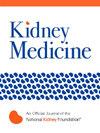Body Composition and Kidney Outcomes: A Cohort Study of Rapid Kidney Function Decline and a Mendelian Randomization Analysis of CKD Incidence
IF 3.4
Q1 UROLOGY & NEPHROLOGY
引用次数: 0
Abstract
Rationale & Objective
Chronic kidney disease (CKD) is a global health issue, potentially arising from rapid kidney function decline (RKFD). Although body composition influences various metabolic disorders, its relationship with kidney outcomes remains unclear. This study aimed to investigate the impact of body composition on RKFD and CKD risk.
Study Design
A cohort study assessed the relationship between body composition and RKFD. A 2-sample Mendelian randomization approach investigated genetic evidence linking body composition to CKD risk.
Setting & Participants
In total, 229 adults aged 50-70 years with normal kidney function were recruited from Huadong Hospital in Shanghai, China.
Predictors
Body composition indicators include fat mass, lean mass, appendicular lean mass index, fat mass index, total and regional body fat percentages, and sarcopenic obesity, defined by high body fat percentages (>27% in men, >38% in women) and low lean mass (appendicular lean mass index <7.26 kg/m2 in men, <5.45 kg/m2 in women).
Outcomes
The primary outcome was RKFD. The second was genetically predicted CKD risk.
Analytical Approach
Cox regression and subgroup analyses assessed observational associations. The Mendelian randomization study used two-sample Mendelian randomization, multivariable, and bidirectional Mendelian randomization.
Results
RKFD occurred in 9.9% of participants. Lower appendicular lean mass index and the presence of sarcopenic obesity were associated with higher RKFD risk. In overweight participants and those with baseline estimated glomerular filtration rate >90 mL/min/1.73 m2, the negative association between appendicular lean mass index and RKFD remained significant. Mendelian randomization analysis revealed that genetically predicted legs and whole-body fat percentages increased CKD risk, whereas appendicular muscle mass was negatively associated with CKD.
Limitations
Differences between the outcomes require further validation. Some sample overlap in the Mendelian randomization analysis may introduce bias.
Conclusions
Lower appendicular lean mass index and sarcopenic obesity were associated with RKFD. Higher leg and whole-body fat percentages and lower appendicular muscle mass significantly contribute to CKD risk, highlighting the importance of body composition in kidney health.
Plain Language Summary
Body composition, such as fat and muscle mass and percentage, may play a role in kidney outcomes. In this study, we followed a group of middle-aged to old adults with normal kidney function to see how body composition affects how quickly kidney function declines over time. We further explore whether genetically predicted fat percentages and lean mass in certain body parts can increase the risk of developing chronic kidney disease. We found that people with less muscle and with higher body fat percentage were more likely to experience rapid kidney function decline or develop kidney disease, suggesting body composition management may prevent kidney problems.
身体组成和肾脏结局:肾功能快速下降的队列研究和CKD发病率的孟德尔随机化分析
目的慢性肾脏疾病(CKD)是一个全球性的健康问题,可能由肾功能快速下降(RKFD)引起。虽然身体成分影响各种代谢紊乱,但其与肾脏预后的关系尚不清楚。本研究旨在探讨身体成分对RKFD和CKD风险的影响。研究设计一项队列研究评估了身体成分与RKFD之间的关系。两样本孟德尔随机化方法调查了身体成分与CKD风险相关的遗传证据。研究对象从中国上海华东医院招募了229名年龄在50-70岁、肾功能正常的成年人。身体组成指标包括脂肪质量、瘦质量、阑尾瘦质量指数、脂肪质量指数、总体脂率和局部体脂率以及肌肉减少型肥胖,定义为高体脂率(男性27%,女性38%)和低体脂率(男性7.26 kg/m2,女性5.45 kg/m2)。主要终点为RKFD。第二个是基因预测CKD风险。分析方法:cox回归和亚组分析评估观察性关联。孟德尔随机化研究采用双样本孟德尔随机化、多变量孟德尔随机化和双向孟德尔随机化。结果rkfd发生率为9.9%。阑尾低瘦质量指数和肌肉减少型肥胖与较高的RKFD风险相关。在超重参与者和基线肾小球滤过率估计为90 mL/min/1.73 m2的参与者中,阑尾瘦质量指数和RKFD之间的负相关仍然显著。孟德尔随机分析显示,基因预测的腿部和全身脂肪百分比增加了CKD风险,而阑尾肌肉质量与CKD呈负相关。局限性:结果之间的差异需要进一步验证。孟德尔随机化分析中的一些样本重叠可能会引入偏倚。结论阑尾瘦质量指数较低和肌肉减少型肥胖与RKFD有关。较高的腿部和全身脂肪百分比以及较低的阑尾肌肉质量显著增加CKD风险,突出了身体成分在肾脏健康中的重要性。身体组成,如脂肪和肌肉的质量和百分比,可能在肾脏预后中起作用。在这项研究中,我们跟踪了一组肾功能正常的中老年人,以了解身体成分如何影响肾功能随时间下降的速度。我们进一步探讨基因预测的某些身体部位的脂肪百分比和瘦质量是否会增加患慢性肾脏疾病的风险。我们发现,肌肉较少、体脂率较高的人更容易经历肾功能快速衰退或患上肾脏疾病,这表明身体成分管理可以预防肾脏问题。
本文章由计算机程序翻译,如有差异,请以英文原文为准。
求助全文
约1分钟内获得全文
求助全文

 求助内容:
求助内容: 应助结果提醒方式:
应助结果提醒方式:


